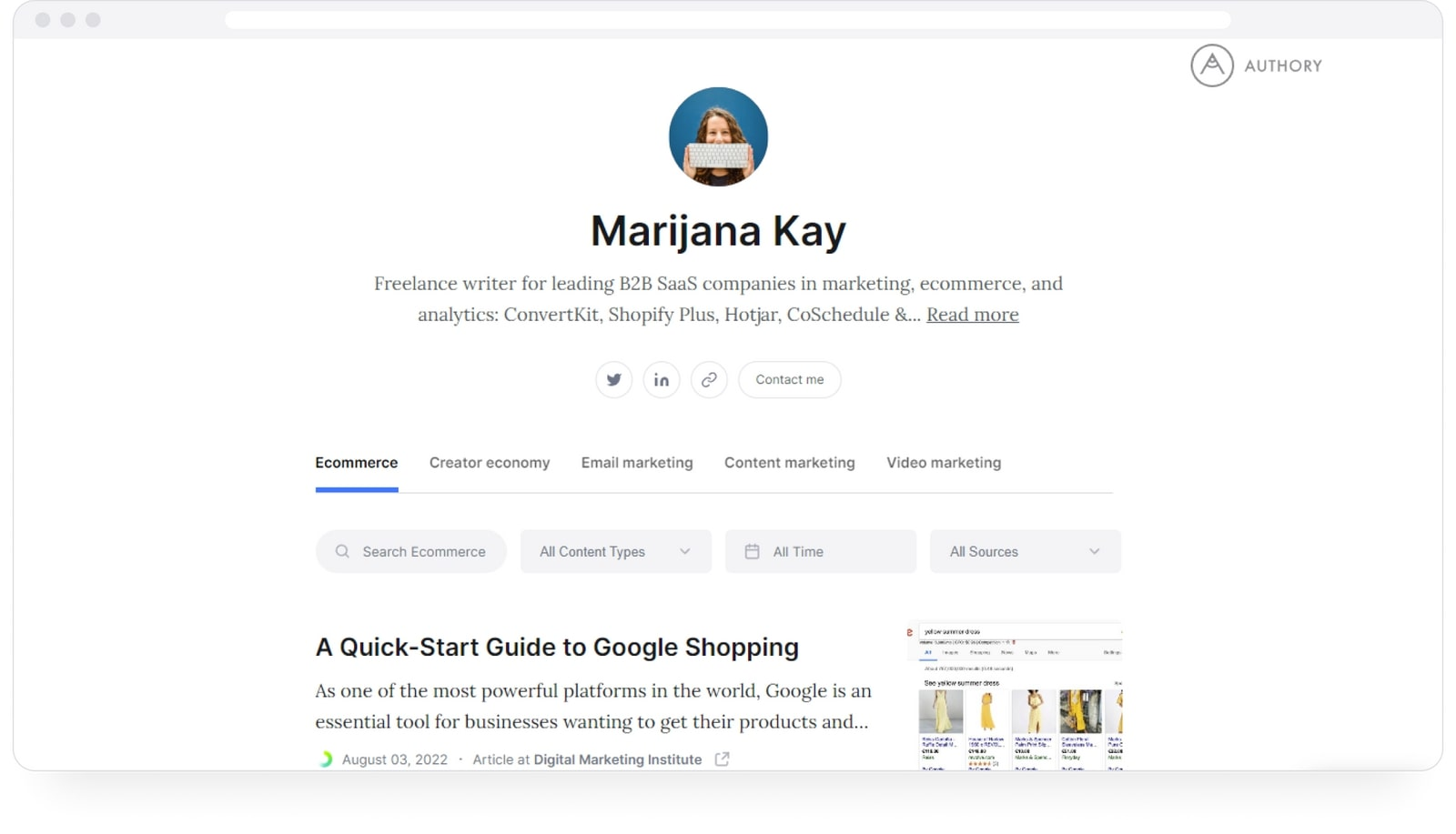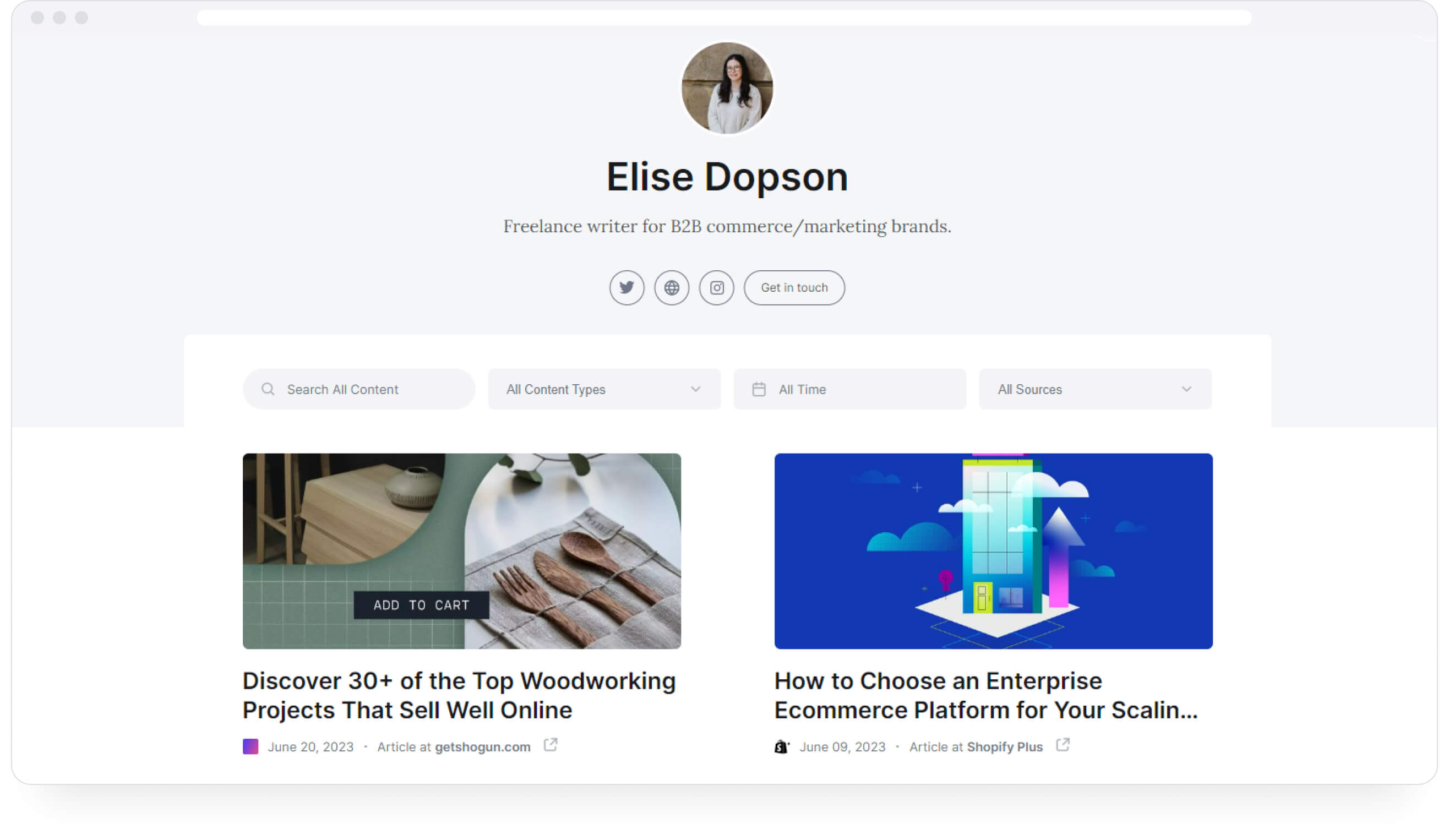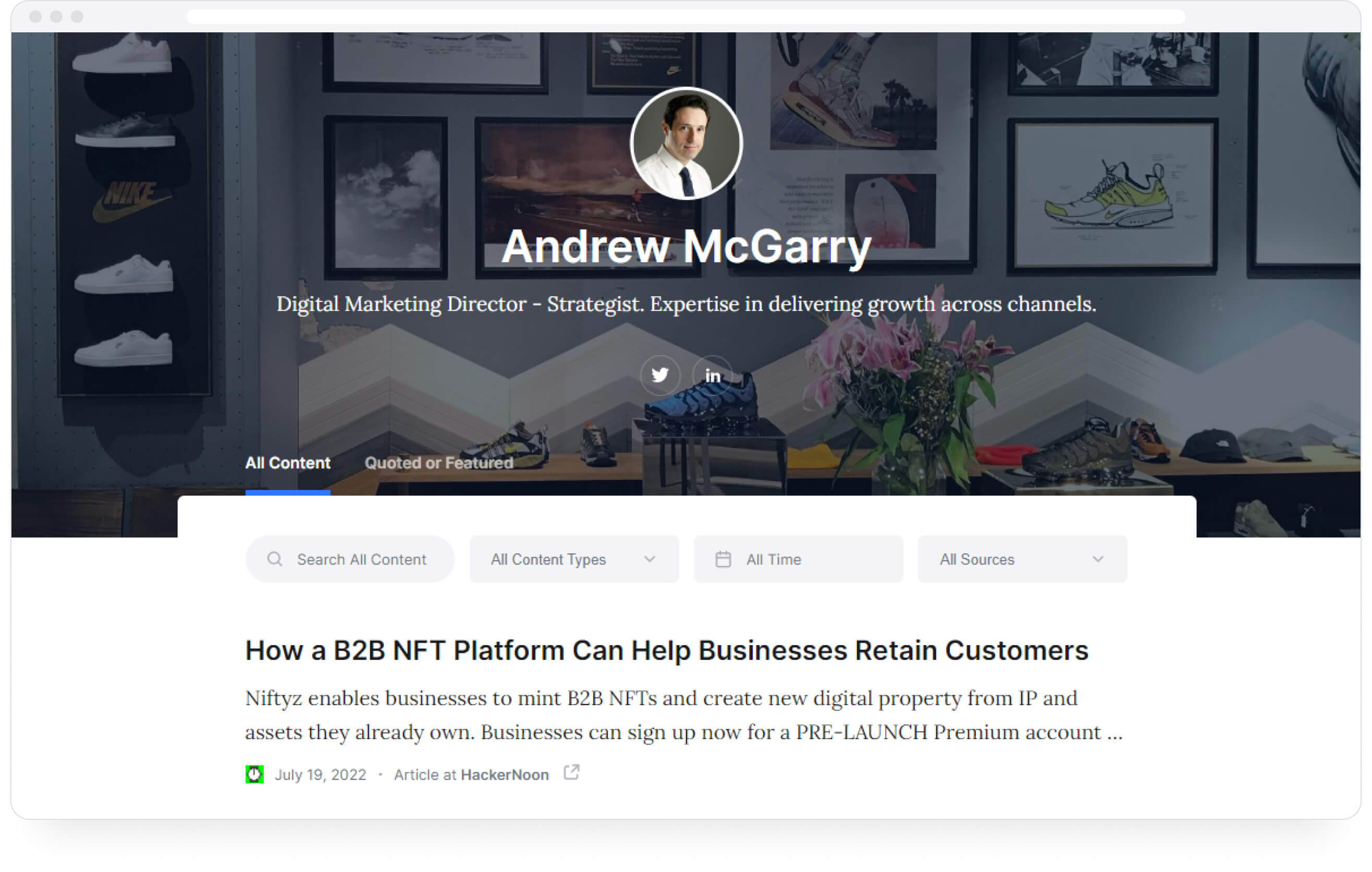Dear digital marketer, do you have a digital marketing portfolio? If not, read on. Everything you need to get started is in this article. If, however, you do have a portfolio website, I'd still recommend that you read on.
Not only will I discuss what goes into an ideal digital marketing portfolio, but I'll also be throwing out some industry-best marketing portfolio examples you can use to upgrade your existing portfolio.
I'll also suggest a portfolio-building tool that'll do most of the work to create a marketing portfolio that potential clients will notice every single time.
• What goes into a top-shelf digital marketing portfolio
• How to create a digital marketing portfolio with minimal time & effort • Examples of excellent digital marketing portfolios
• Why Authory is the ideal portfolio builder — automatic importing of all bylined content AND automatic backup of ALL your imported content
Essential elements of great digital marketing portfolios
Tangible content
Unlike writers, designers, or even developers, digital marketing professionals like you don't have obvious "work samples." In all likelihood, you create strategies that get implemented by teams in the form of tangible output — articles, videos, web content, etc.
Therefore, as a marketing professional, you must find and feature tangible work on your online portfolio. Examples of this would be website copy, ads, social media content, videos, podcasts, etc. The only criterion is that you should be the one who created the strategy that led to this content's existence. If you were involved in the execution as well, then that’s an added bonus.
Finally, don't forget to credit your teammates who have helped execute your plans while expanding on your role in the team.
A great "About" section
The "About" section in your portfolio needs to summarize your achievements, skills, and services. Don't forget to add your contact info and professional social media accounts.
Open with a title, speak about your current work as a digital marketing professional, mention specializations & end with a line of personal confessions (maybe you like collecting vintage mugs, maybe you love hiking in Yosemite).
A few tips to create a great "About Me" from an actual digital marketer & SEO expert:
Start with a title that coalesces your career into a few words. I've gone for "Product-led Marketer | Startup Founder, Advisor & Consultant" to encapsulate the various aspects of my career. (I love using the "|" symbol to squeeze a few more details into my title.)
Then expand on your current career stage. So, I'd say something like, "I'm the Director of Content Marketing at Authory."
And then, add a brief history of your recent work. I'd probably say, "Recently, I've been in the developer-tooling industry, working primarily in the content & SEO space for companies like Hasura (Series C of $100M). I've also been a marketing consultant to numerous startups from Seed-stage to Series C."
If you like, you can conclude it by touching upon your past work. I usually go with, "In the past, I've run a branding, advertising & digital marketing agency for over seven years, where we served over 100 clients, including conglomerates like Vodafone, Ford, ITC, and Wipro."
Work samples (All your work)
Traditional portfolio-building wisdom tells us that you only include your best work in your portfolio. However, contemporary employers & potential customers want quality with quantity. Potential employers want to see that you do good work consistently and that you’re prolific in creating great work (in any format) at a decent cadence.
If you're not sure about whether you can include a certain piece of content in your portfolio, don't forget to ask the client and get consent. In case you don't get consent and you have to show that work to a particular client (not the world), you can still make it work with a tool like Authory.
Work under NDAs, ghostwritten or agency-owned content
Digital marketers often have to work with clients who don't want them to showcase your work on their profiles on your portfolio. This is especially true when you have signed an NDA (non-disclosure agreement), if you're a ghostwriter, or if you've worked with a client (like a government agency) required to keep their workings with a certain client confidential. Or perhaps, you've worked on the UX content strategy and UX writing for a site or product, and the work sample is the site/app itself.
You'd think there is no way to get around this, but there is if you use certain tools. Of course, if you'd rather go the long way, you can reach out to get the client's consent or obscure their name from the testimonials, text, images, etc.
The easiest way, however, is to display this content within a private link. Build a portfolio site that doesn't showcase this work to everyone but allows you to create a private collection to be shared with potential clients’ confidence.
Organized presentation of all your work samples
If you're like me, you've been working with brands in diverse industries. In my case, I've written about everything from software testing to music to "how to create portfolios" to DaaS tools for a few years now. If so, finding a way to organize your content by topic, domain, or project on your portfolio is quite helpful. You really cannot expect people to painstakingly find their way and evaluate your work in a heap of unrelated content pieces.
For example, in my portfolio, I have articles under the following headers — Software testing, All The Music, Application Streaming & Cloud PCs, Creating a Work Portfolio?, Video Engineering & Streaming for Developers. Anyone can just click on one of these headers to explore the content assigned to them.
Consistently updated content
It's ideal that you place every single piece of content on your portfolio as soon as it sees the light of the public internet. In the real world, however, this is easier said than done.
You can't be expected to manually upload or copy-paste every new piece of published content, especially if your work is published frequently. However, you can use a tool (like Authory) that automatically updates your portfolio with your latest work (as long as it is bylined). All you have to do is enter the URL of the sites where your work is published, and the tool will take care of the rest.
How to build a digital marketing portfolio website with very little effort
Authory is a dedicated portfolio-building platform, which allows users to create a professional work portfolio in literally a few minutes. To create a portfolio with ALL your content (in different formats), follow the steps below:
- Sign up for Authory (for FREE) using this link.

Once I choose “Continue with Google” and enter my email ID, the tool automatically fills in the fields for my name (taken from my email data).

- I chose my profession as “Writer” and then click “Next Step.”

In the next screen, I see that Authory has already automatically found the “sources” — websites where my bylined articles are published (nytimes.com & washingtonpost.com, for example). Of course, if it has missed a source, I can add it manually (just the site URL), OR I can choose to add all my sources manually.
- Click “+ Add.”
Authory will take up to 48 hours (often less) to import every bylined article to its database. Once the process is complete, you can segment your articles, videos, podcasts, audio files, and social media posts into relevant “Collections” — think of them as folders within your Authory database.
Creating a Collection on Authory
Once all your work has been imported by Authory, go to the “Collections” tab on your Authory dashboard.

- Click “+Create Collection.” You’ll see that I already have a set of Collections in the mix.

- Add a name and description to your new Collection. Click “Add.”

- You’ll be taken inside your new Collection. Click “Go to Content” next to the “Manually” option.

- Once you click “Go to Content,” you’ll be taken back to your main content dashboard. Since Authory has already imported your pieces, you can select the ones you want to slot into this particular Collection.

- Select the relevant files (articles in my case), click “+ Add to collection” to the bottom right (highlighted above), find the name of the Collection you created, and click on it.
- Go back to the “Collection” tab you clicked before on the dashboard. You’ll see your new Collection.

Adding your Collection to your Authory portfolio
- Now that you’re done creating a Collection(s), it’s time to add it to your portfolio. Go to the “Portfolio” option on your dashboard.

- Click the “Content” drop-down to the left. Click “Add collection.”

- Choose the Collection you just created — “New Collection,” in my case.

- And voila! Your new collection has been added to your portfolio.

- To check the final product, click “Go to portfolio” on the left.

- You’ll be taken to your portfolio in a separate window. This is what clients will see when you send them your Authory portfolio.

If you’d like to explore this example portfolio, feel free to do so: https://authory.com/shreya-bose
Digital marketing portfolio examples
Marijana Kay

Marijana Kay is a digital marketing professional and a freelance writer for B2B SaaS companies in marketing, e-commerce, and analytics. She has worked with brands like ConvertKit, Shopify Plus, Hotjar, CoSchedule & more.
Elise Dopson

Elise Dopson's online portfolio is impressively minimal and doesn't say much except that she is a freelance writer for B2B commerce and marketing brands. Clearly, she prefers to let her work do the talking.
Andrew McGarry

Andrew MacGarry is a digital marketing director & strategist. Not only does he include content he created himself, but also content in which he has been quoted & featured. This lets clients see that you're a marketing professional whose ideas are valuable to the industry at large.
Why use Authory to create a digital marketing portfolio website?
So, now that you've seen these exceptional portfolios, I highly recommend using Authory to create industry-best portfolios (like the ones above) in literal minutes.
Authory doesn’t just give you the space to copy-paste links to your work. It literally does over half the work — finding all bylined content you’ve ever published, importing it automatically, saving it permanently (again, automatically), and enabling you to organize your pieces into different collections.
A self-updating portfolio (no need to keep adding new work manually)
Authory will AUTOMATICALLY import a copy of every bylined piece from every site into its own database.
These sites are called "sources." You add as many sources as you want, and every single bylined piece from every single source will be imported automatically.
You don't have to track down links to your published work (especially older pieces). As long as you remember the URL of the site where your work exists, Authory will collate all your content for you in one dashboard.
Authory can import content from behind most soft paywalls (as long as it is a bylined piece) and some hard paywalls. However, it cannot be used to import copies of articles, podcasts, and videos you haven’t created or featured in.
There isn’t any need to manually upload/copy-paste your content. That said, if you happen to have any non-bylined content, you can always do so manually in those cases.
Automated backups (never lose your content, ever)
All the content that Authory imports from different sources is saved permanently. You'll never have to worry about losing any of your published work. Even if the original website where it's published goes defunct for any reason, you'll always have a copy safely stored on Authory's server.
All backups are in the original format — text and/or media. No screenshots. This is super important because it lets you search through your content database, making it a valuable research tool.
Continued importing of past and future content (less effort for a 100% updated portfolio)
Once you enter a source, Authory won't just import your existing publications. Anything you publish on the same site (after you've fed its URL into Authory) in the future will also be imported automatically. In other words, Authory will import your past and future content.
Authory also sends email notifications for every new piece it imports, so you'll always know if something you submitted has been published.
Apart from these, you also get a slew of miscellaneous but necessary features:
- Ability to search through both your portfolio and your content database to find articles/audio/videos based on keywords. Prospective employers and hiring managers can use this to look for topics on your portfolio, and you can use it to find specific pieces within your Authory content bank.
- Ability to create a custom domain with a click.
- All imported content can be downloaded as high-res PDFs or exportable as HTML files — no lock-in period.
- Get a custom domain and personalize your portfolio even further.
- Multiple, low-effort options for customization to make your portfolio visually appealing and easy to navigate.
- In-built analytics that provides real numbers on content performance (engagement, readership) across the web and popular social media sites every 30 days. You get to see how your readers/viewers are responding to your work.
- Allows creation of newsletters with a couple of clicks. After setup, Authory will automatically send your newly published content to subscribers.
- Widgets to display your personal portfolio on other sites, such as your personal website (if you have one).
Curious? Get started for FREE and see what Authory has to offer you!




